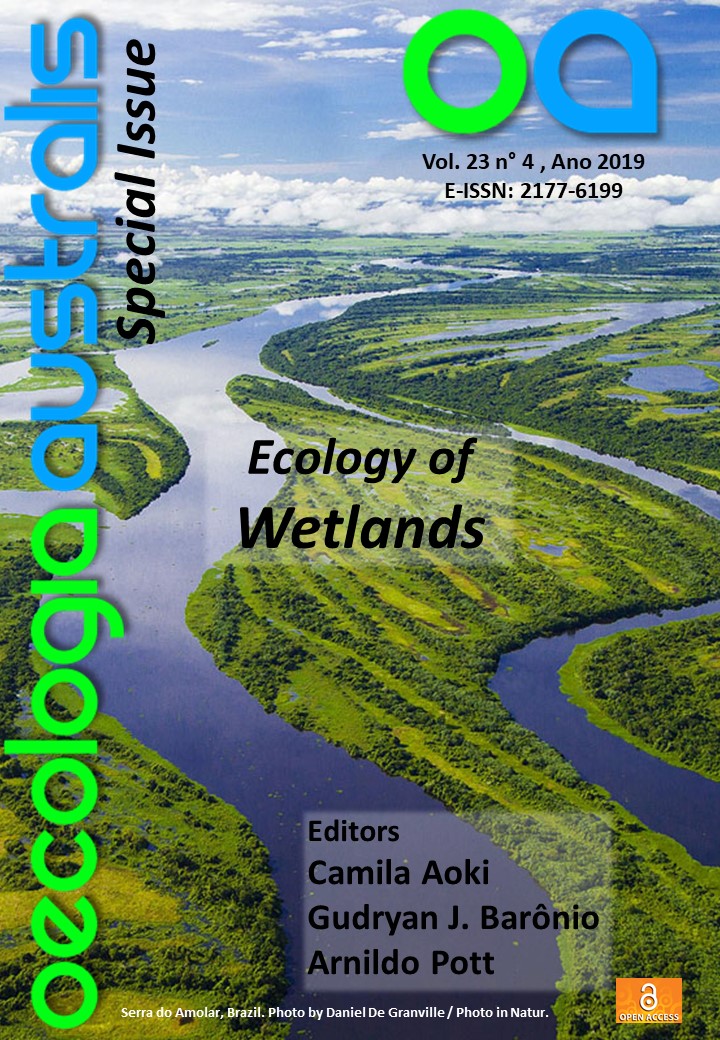CHARACTERIZATION OF THE BIOTIC (MACROPHYTES AND MACROINVERTEBRATES) AND ABIOTIC FACTORS OF PANTANAL PONDS IN THE MIRANDA RIVER FLOODPLAIN
DOI:
https://doi.org/10.4257/oeco.2019.2304.17Keywords:
biodiversity, environmental characterization, hydrology, Neotropical flora, wetlandsAbstract
The Pantanal has an exuberant biodiversity that is constantly regulated by the dynamics of the climate and by the flood pulses. The objective of this work was to characterize and evaluate the biotic (macrophytes and macroinvertebrates) and abiotic factors (pH, temperature, dissolved oxygen, conductivity, total dissolved solids, water turbidity, chlorophyll a and pheophytin-a) of Pantanal ponds depending on the dry or rainy season. Therefore, five ponds with different characteristics were analyzed and five samples of water were collected during the dry and rainy season. For sampling of the macrophytes and collection of the macroinvertebrates we used hand nets (area of 0,09m2, opening of 5000 μm). This was done in order to observe seasonal difference in pH, chlorophyll-a and pheophytin-a and spatial differences between dissolved oxygen, electrical conductivity, turbidity, chlorophyll a and pheophytin-a was observed. The aquatic macrophyte Eichornia azurea ( Commelinales, Ponteridaceae) showed high dominance and relative vegetation cover in at least three ponds, which was also related to higher values of macroinvertebrate biomass. On the other hand, the ponds that presented low dominance or absence of E. azurea presented high diversity of aquatic macrophytes. However, these intrinsic biological characteristics of the ponds altogether with the abiotic parameters demonstrated that there are distinct patterns in the dynamics of these ecosystems during the drought and flood regimes.
Downloads
References
Alho, C. J. R., & Gonçalves. H. C. 2005. Biodiversidade do Pantanal – Ecologia & Conservação. Campo Grande: Editora UNIDERP: p. 135.
Brower, J. E., & Zar, J. H. 1984. Field & laboratory methods for general ecology. Boston: W.C. Brown Publishers: p. 226.
Carvalho, E. M., & Uieda, V. S. 2004. Colonização por macroinvertebrados bentônicos em substrato artificial e natural em um riacho da serra de Itatinga, São Paulo, Brasil. Revista Brasileira de Zoologia, 21(2), 287–293. DOI: 10.1590/S0101-81752004000200021
Catian, G., Leme, F. M., Francener, A., Carvalho, F. S., Galletti, V. S., Pott, A., Pott, V. J., Scremin-Dias, E., & Damasceno-Junior, G. 2012. Macrophyte structure in lotic-lentic habitats from Brazilian Pantanal. Oecologia Australis, 16(4), 782–796. DOI: 10.4257/oeco.2012.1604.05
CETESB - Companhia Ambiental do Estado de São Paulo. 2014. Determinação de clorofila a e feofitina a: método espectrofotométrico. Norma Técnica L5.306. 3º ed. p. 14.
Diniz, F. M., Santos, M. O., & Melo, S. M. 2018. Levantamento da fauna de macroinvertebrados associados à macrófitas aquáticas. Journal of Environmental Analysis and Progress, 3(1), 86–91. DOI: 10.24221/jeap.3.1.2018.1693.086-091
Eaton, D. P. 2006. Contribuição para conservação de macroinvertebrados, peixes e habitats de água doce no Pantanal de Nhecolândia e do Rio Negro, Mato Grosso Do Sul. Ensaios e Ciência: Ciências Biológicas, Agrárias e da Saúde, 10(1), 99–118.
Esteves, F. A. 1998. Fundamentos de limnologia. Rio de Janeiro: Interciência: p. 602.
Flora do Brasil 2020 em construção. Jardim Botânico do Rio de Janeiro. Retrieved on 12 September, 2019, from http://floradobrasil.jbrj.gov.br/
Marengo, J. A., Alves, L. M., & Torres, R. R. 2015. Regional climate change scenarios in the Brazilian Pantanal watershed. Climate Research, 68(2), 201–213. DOI: 10.3354/cr01324
MMA – Ministério do Meio Ambiente. 2007. Biodiversidade do Cerrado e Pantanal: áreas e ações prioritárias para conservação da biodiversidade. Série Biodiversidade 17. Brasília: MMA.
Moretti, M. S., Goulart, M. D. C., & Callisto, M. 2003. Avaliação rápida da macrofauna associada a Eichhornia azurea (Swartz) Kunth, 1843 e Pontederia lanceolata Nutt., 1818 (Pontederiaceae) na Baía do Coqueiro, Pantanal de Poconé (MT/Brasil). Revista Brasileira de Zoociências, 5(1), 7–21.
Oliveira-Junior, E., Butakka, C. M. M., Silva, C. J., & Muniz, C. 2013. A influência do pulso de inundação na ecolimnologia de baías pantaneiras: um estudo na dinâmica de invertebrados aquáticos. Holos Environment, 13(2), 188–199. DOI: 10.14295/holos.v13i2.6688
Oksanen, J., Blanchet, F. G., Friendly, R., Kindt, R., Legendre, P., McGlinn, D., Minchin, P. R., O'hara, R. B., Simpson, G. L., Solymos, P., Stevens, M. H. H., Szoecs, E., & Wagner, H. 2018. Vegan: Community Ecology Package. R package version 2.0–10. Retrieved on July 20, 2018, from http://CRAN.R-project.org/package=vegan
Peiró, D. F., & Alves, R. G. 2006. Insetos aquáticos associados a macrófitas da região litoral da represa do Ribeirão das Anhumas (município de Américo Brasiliense, São Paulo, Brasil). Biota Neotropica, 6(2), 1–9. DOI: 10.1590/S1676-06032006000200017
Pott, V. J., & Pott, A. 2000. Plantas aquáticas do Pantanal. Brasília: Embrapa: p. 404.
Pott, V. J., & Pott, A. 2003. Dinâmica da vegetação aquática do Pantanal. In: S. T. Thomaz, & Bini, M. B. Ecologia e manejo de macrófitas aquáticas. pp.143–162. Maringá: EDUEM.
Pott, A., & Pott, V. J. 2004. Features and conservation of the Brazilian Pantanal. Wetlands Ecology and Management, 12(6), 547–552. DOI: 10.1007/s11273-005-1754-1
R Core Team. 2015. R: A language and environment for statistical computing. R Foundation for Statistical Computing, Vienna, Austria. Retrieved on July 20, 2018, from http://www.R-project.org/
Santos-Junior, A., & Costacurta, M. B. 2011. Dinâmica da composição e cobertura de espécies de macrófitas aquáticas e a escolha de indicadores de impacto ambiental em um rio com ecoturismo. Ambiência Guarapuava, 7(3), 535–550. DOI: 10.5777/ambiencia.2011.03.10
Saulino, H. L., & Trivinho-Strixino S. 2014. Macroinvertebrados aquáticos associados às raízes de Eichhornia azuera (Swarts) Kunth (Pontederiaceae) em uma lagoa marginal no Pantanal, MS. Biotemas, 27 (3), 65–72. DOI:10.5007/2175-7925.2014v27n3p65
Silio-Calzada, A., Barquín, J., Huszar, V. L. M., Mazzeo, N., Méndez, F., & Álvarez-Martínez, J. M. 2017. Long-term dynamics of a floodplain shallow lake in the Pantanal wetland: Is it all about climate? Science of the Total Environment, 605(606), 527–640. DOI: 10.1016/j.scitotenv.2017.06.183
Silva, F. H., Favero, S., Sabino, J., & Garnés, S. J. A. 2009. Distribuição da entomofauna associada às macrófitas aquáticas na vazante do rio Correntoso, Pantanal do Negro, Estado do Mato Grosso do Sul, Brasil. Acta Scientiarum, Biological Sciences, 31(2), 127–134. DOI: 10.4025/actascibiolsci.v31i2.1182
Silva, R. M. M., & Carniello, M. A. 2007. Ocorrência de macrófitas em lagoas intermitentes e permanentes em Porto Limão Cáceres-MT. Revista Brasileira de Biociências, 5(2), 519–521.
StatSoft. 1996. Statistica 5.1 for Windows. Tulsa, USA.


